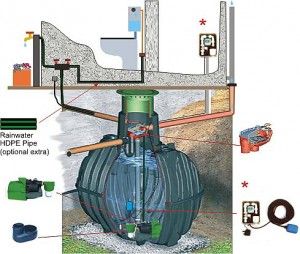Some of the latest Met Office statistics suggest that England is already short of water and there has been official encouragement for us to reduce mains water consumption both by maximising the use of rainwater and using water-efficient appliances. The average home or businesses can waste a lot of water every single day. In recent times there has been an increase in water bills, and the changes in the climate have resulted in summer hosepipe bans in parts of the country.

Rainwater Harvesting
One of the best ways to use this scarce commodity wisely is though the installation of a Rainwater Harvesting collection tank. Rainwater is free and can be used for many domestic and commercial uses. Rainwater can be used in domestic household appliances and to water gardens. Homes that use a water tank to collect water can save money by reducing their water bill and also helping to protect the environment.
You can find various types of water tanks in Norwich, different amounts of water can be stored depending on the size of your water tank. They are available for both domestic and commercial premises. The size of water tank will depend on how much water you want to collect and how you wish to use it. For garden use, there are simple water butts that come in many shapes and sizes. If you want to store larger amounts and use it for your home and garden, you will need a water tank. Both above and below ground in water tanks are available. To install an indoor water tank for drinking water, you’ll need a filter and a UV cleaner and it is always best to use the services of a professional plumber in Norwich.
Having a Norwich Plumber fit a water tank for you can be a huge money saver in the long term as you can collect as much water as you want. Also, hosepipe bans will not affect you as you can use the water however you like. Not only are water tanks easy to install, they’re very low maintenance. If you have your own water supply, rises in water bills will not affect you. If we install your water tank, you’re helping the environment by no longer wasting water.
Top Rainwater Harvesting Tips
- It is best to bury the tank underground: the 10°C cool of the ground inhibits bacterial action and the water is less likely to discolour.
- Plan your rainwater system early: you need to check the inverts (the levels of the rain pipes, tank and drain or soakaway)
- Choose a supplier which provides an accurate tank size calculation and a written quote conform with BS 8515 – 2009: you want to be certain to have the trouble-free equipment which will get the approval of your council inspector.
- If you are not on the main drain, dig a double size soakaway for tank overflow and debris: most modern filters in the head of the tank are self-cleaning. Water flowing over it sends debris out through siphon to drain or soakaway. This all means No or very little maintenance.
- Equip the submersible pump with a floating intake. Why? Because it skims the freshest and cleanest water from just below the surface of the water.
- Equip the submersible pump with a float switch: even if the pump has dry run protection, there is a risk that it would burn itself out when the tank empties repeatedly in summer.
- If you have ground water within a metre of the surface, concrete the tank in: otherwise when it’s empty its buoyancy will float the whole tank out of the ground.
- Connect all the downpipes off the house to the tank: get all the possible water off the roof when it rains. Use rainwater hdpe pipe which is required by Water Companies and Authorities to be black and green
- Do not collect surface water and run it into the rainwater tank: you’ll want to avoid oil spills and dog mess getting into the water if you’re flushing toilets and washing clothes with it.
- Consider a smart header tank with your rain system: it reduces electricity use by ten, reduces wear and tear on the pump and appliances (gentle gravity feed) and ensures water supply in a power cut. But do not install a standard header tank because the rainwater in the warmth of the roofspace will go yellow through bacterial action when you go on holiday.
You should contact a well-established Norwich plumber for your water tank queries. Not just anyone should be trusted with your water tank installation. At T.S.M. Plumbing, professional plumbers can provide advice on how to best use your new water tank. High-quality service and customer satisfaction are key.
Credit to: rainwaterharvesting.co.uk for the top 10 tips. Thanks guys!
